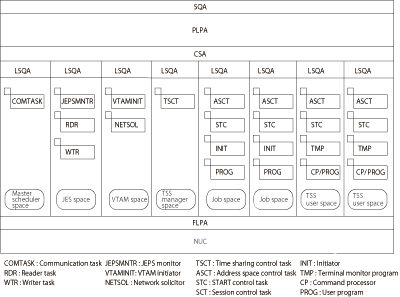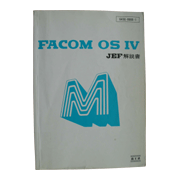OSIV/F4 (*) was one of the operating systems (hereinafter “OS”) for Fujitsu’s FACOM M series general-purpose computers, and was a super-large general-purpose OS. The OS was announced in November 1974 together with the super-large general-purpose computer FACOM M-190.
The following describes the features of OSIV/F4, its major functions and functional enhancements.
*: OSIV/F4 was pronounced “OS four F four” The letters “OSIV” represented 4th generation OSs, and were added to the heads of the names of all OSs for the FACOM M series computers.
1. Features of OSIV/F4
OSIV/F4 was newly developed in order to provide functions and performance at the highest level, and it had the following features:
OSIV/F4 was newly developed in order to provide functions and performance at the highest level, and it had the following features:
(1) Achievement of a system with high levels of processing capacity, expandability and reliability
The OS efficiently controlled the hardware of the FACOM M series, including a multiprocessor system consisting of up to 4 CPUs, by adopting a multiple virtual memory control, and it achieved high levels of system processing capability and expandability.
In addition, it provided functions for building a high-reliability system in conjunction with the RAS (Reliability Availability Serviceability) function of the hardware.
The OS efficiently controlled the hardware of the FACOM M series, including a multiprocessor system consisting of up to 4 CPUs, by adopting a multiple virtual memory control, and it achieved high levels of system processing capability and expandability.
In addition, it provided functions for building a high-reliability system in conjunction with the RAS (Reliability Availability Serviceability) function of the hardware.
(2) Provision of online database AIM (Advanced Information Manager)
The OS provided the online database AIM, which integrated an online function and a database function based on a new concept, allowing the user to easily build an optimal online database system.
The OS provided the online database AIM, which integrated an online function and a database function based on a new concept, allowing the user to easily build an optimal online database system.
(3) Easy-to-use system operating functions
In order to ease the burden on the operators, the OS provided easy-to-use functions of system operation, which were including functions for improving operability, a function for managing files in an integrated manner and a simple job scheduling function.
In order to ease the burden on the operators, the OS provided easy-to-use functions of system operation, which were including functions for improving operability, a function for managing files in an integrated manner and a simple job scheduling function.
(4) Functions for realizing easy application development
The OS provided high-level languages processing programs, an advanced function of the language-processing program to make program development easy, tools for TSS-based application development, and so on.
The OS provided high-level languages processing programs, an advanced function of the language-processing program to make program development easy, tools for TSS-based application development, and so on.
(5) International compatible functions
The OS achieved compatibility with IBM OS/VS1 in job control languages, application programs (source codes and load modules), and data files.
The OS achieved compatibility with IBM OS/VS1 in job control languages, application programs (source codes and load modules), and data files.
2. Major features of OSIV/F4
Major features of OSIV/F4 included:
Major features of OSIV/F4 included:
(1) Functions for increasing the processing capacity and expandability of the system
The OS was aimed at realizing high system processing capacity and system expandability through the following functions:
The OS was aimed at realizing high system processing capacity and system expandability through the following functions:
- Multiple virtual memory control function capable of allocating up to 1,536 16-MB virtual address spaces
- Tightly-coupled multiprocessor control function in a configuration consisting of up to 4 CPUs (achieved with FACOM M-200)
- Reduction of the overhead in the I/O control of the OS through utilization of channel DAT (Dynamic Address Translation) and channel cross call
- VSAM (Virtual Storage Access Method), designed to increase processing capacity and utilization of the file device
- VIO (Virtual Input Output) function for increasing the processing efficiency of the system
The OS achieved acceleration of the I/O operation speed by allocating temporary files to a virtual memory space.
The OS achieved acceleration of the I/O operation speed by allocating temporary files to a virtual memory space.
-Provision of VTAM (Virtual Telecommunication Access Method) and a network control program (NCP) that operated with a communication control processor (CCP)
The OS increased system efficiency though load distribution of the whole system, by having the NCP perform part of the functions that were formerly executed by the host computer.
The OS increased system efficiency though load distribution of the whole system, by having the NCP perform part of the functions that were formerly executed by the host computer.




